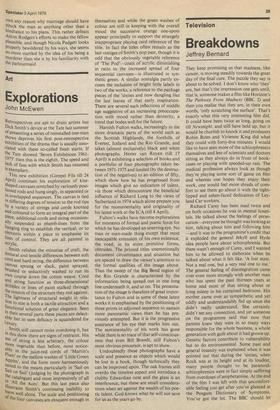Art
Explorations
John McEwen
Retrospectives are apt to drain artists but Dick Smith's device at the Tate last summer of presenting a series of reinstalled one-man shows deprives his first post-retrospective exhibition of the drama that is usually asso- ciated with these so-called fresh starts. If the Tate showed 'Seven Exhibitions 1961- 1975' then this is the eighth. The speed and lack of fuss with which Smith has resumed Is exemplary. This new exhibition (Gimpel Fils till 24 April) continues his exploration of kite- shaped canvases stretched by variously posi- tioned rods and hung singly, in separated or 1.11 overlapped sequences. The canvas is tied in differing degrees of tension to the rod tips by a variety of strings and cords knotted and coloured to form an integral part of the Piece, additional cords and string occasion- allY suspended as plumb-lines from the banging ring to establish the vertical, or to elements within a piece to emphasise its hoes of control. They are all painted in acrylic.
Smith relishes the minutiae of craft, the textural and tensile differences between soft cord and hard string, the difference between canvas sprung or slack, paint sprayed, brushed or seductively washed to run its own course down the cotton weave. Cord and string function as three-dimensional dribbles or lines of paint stalked through the tension of the structure they rest against. The lightness of structural weight in rela- tion to size is both a tactile attraction and a functional solution of great elegance. Seen In their several parts these pieces are delect- able but in sum delicacy is squandered for I lixury.
. Smith still cannot resist overdoing it, but In this show there are signs of restraint. His use of string is less arbitrary, the colour more vegetable than before, most notice- anb1Y in the juice-red cords of 'Martin's 'Alum' or the mellow washes of 'Little Green '113.131es', and the form more harmoniously suited to the means particularly in 'Sail on Sail on Sail' (judging by the photograph in the catalogue) and most impressively of all
'All the Aces'. But this last piece also Illustrates Smith's continuing inability to leave well alone. The scale and positioning of the four canvases are eloquent enough in themselves and while the green washes of colour are still in keeping with the overall mood the successive orange one-spots appear principally to support the strangely inappropriate playing card reference of the title. In fact the titles often remain as the last vestiges of Smith's pop past, though it is odd that the obviously vegetable reference of 'The Pod'—coats of acrylic diminishing in ratio to the increased spread of four sequential canvases—is illustrated in syn- thetic green. A similar nostalgia partly ex- cuses the inclusion of bright little labels in two of the works, a reference to the package pieces of the 'sixties and now dangling like the last leaves of that early inspiration. There are several such inflections of middle age suggestive of an increasing preoccupa- tion with mood rather than dexterity, a trend that bodes well for the future.
Hamish Fulton walks, increasingly in the more dramatic parts of the world such as the Scottish Highlands, the foothills of Everest, Iceland and the Rio Grande, and takes (almost exclusively) black and white photographs. Hester van Royen (till 17 April) is exhibiting a selection of books and a portfolio of four photographs taken be- tween 1971-1975 and limited (by the destruc- tion of the negatives) to an edition of fifty, which show how he has progressed from images which give no indication of talent, via those which demonstrate the beneficial influence of Richard Long to the views of Sutherland in 1974 which alone prepare you for the monumentality and originality of his latest work at the ICA (till 4 April).
Fulton's walks have become explorations for moments of formal and poetic force for which he has developed an unerring eye. No man or man-made thing except that most inescapable extension of his own existence, the road, in its more primitive forms, obtrudes. The printed titles unemotionally document circumstance and situation but are spaced to draw the viewer's attention to the formal qualities of the image above. Thus the sweep of the Big Bend region of the Rio Grande is characterised by the information being spread out in one long line underneath it, and so on. The presenta- tion of the image is therefore of great impor- tance to Fulton and in some of these latest works it is emphasised by the positioning of three prints in adjoined sequence to sustain more panoramic views than he has pre- viously attempted. But it is the progressive assurance of his eye that marks him out. The sentimentality of his work has gone while there is no trace of that self-conscious- ness that even Bill Brandt, still Fulton's most obvious precursor, is apt to show.
Undoubtedly these photographs have a scale and presence as objects which would be lost in a book, though technically they can be improved upon. The oak frames still overdo the timeless aspect and introduce a clubby Edwardian note and the glass is an interference, but these are small considera- tions when set against the wealth of his poe- tic talent. God knows what he will not save for us as the years go by.


































 Previous page
Previous page